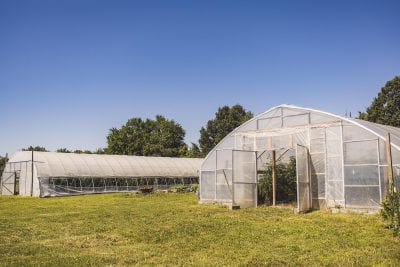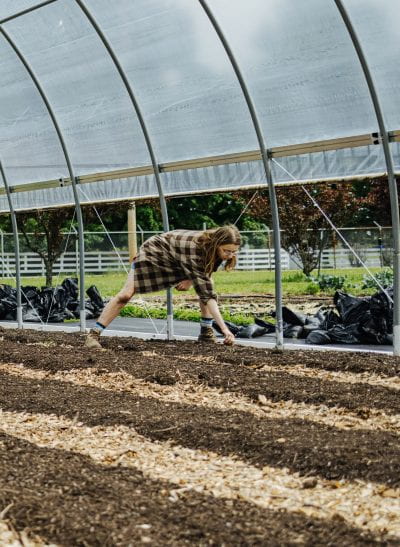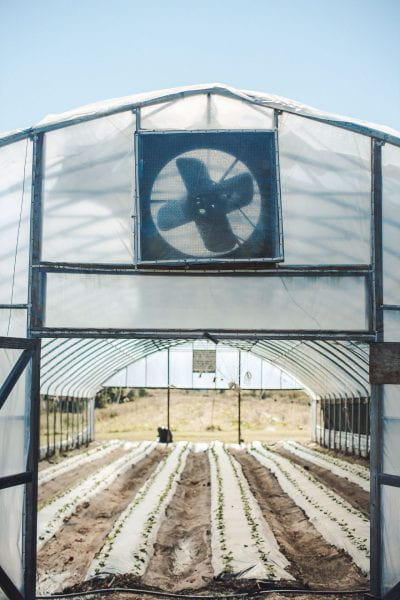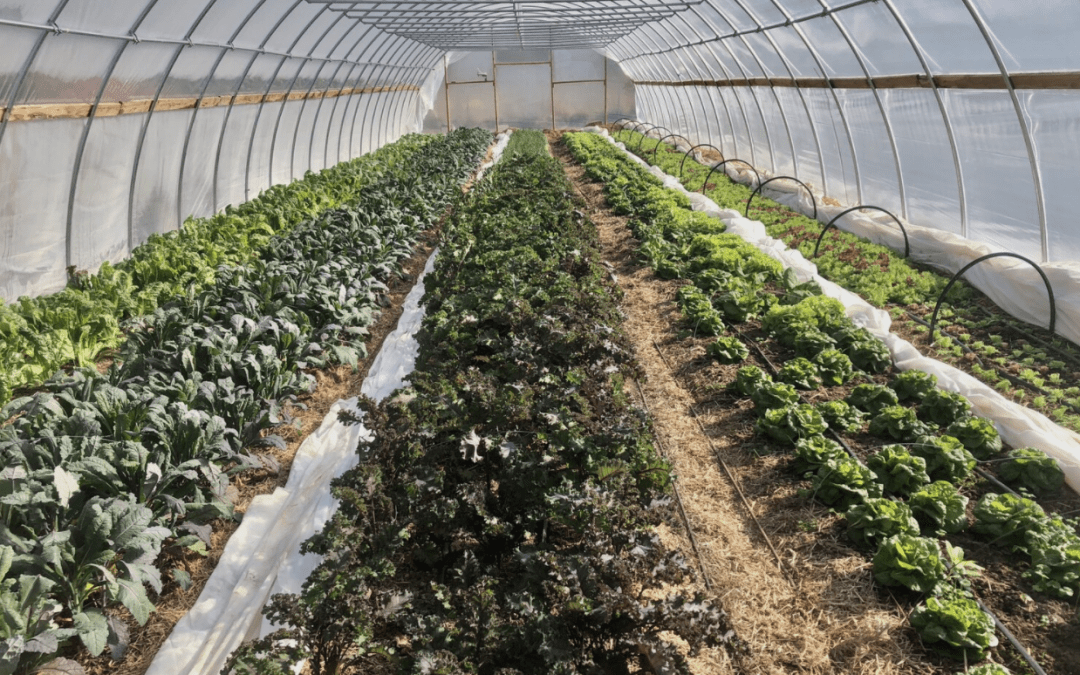On September 18th, the Center for Arkansas Farms and Food will host a beginning farmer class on High Tunnels and Season Extension featuring farmer and author Pam Dawling. This workshop is a “must-attend” for those interested in learning about low-cost methods for protecting crops from cold temperatures and improving yields. If you ask yourself, “what is a high tunnel?” or “why should I care about high tunnels?” This is the blog post for you!

High tunnels are essentially unheated greenhouses that small farmers have found to be especially useful and cost-effective at protecting crops from frosts and other extreme weather events. Most of the time, when high tunnels are discussed in the farming world, they are mentioned in the context of season extension, which refers to the ability to expand the window of time you can harvest crops by protecting them from frost and freezing temperatures. Like a greenhouse, a high tunnel essentially creates a micro-climate around the plants that is slightly warmer than the ambient air, allowing crops to grow farther into the fall than they otherwise would.
High tunnels come in many shapes and sizes – from small, moveable versions suitable for a backyard garden to large mechanized versions designed to grow high-value crops like heirloom tomatoes. The versatility of high tunnel designs fits with the diversity of small farms, making it a perfect fit for the small-scale produce farmer. Most high tunnels have a metal frame covered in plastic film with vents on the sides or ends. The width of the tunnel will typically be 15-20 feet, spanning 3 to 6 vegetable beds, with the length at anything from 20 to several hundred feet. Core concepts and principles for utilizing high tunnels – such as ventilation, materials, and placement – remain the same. Pam Dawling will cover these in her September 18th workshop.
 What are the benefits of growing crops in a high tunnel? In addition to extending the harvest season, high tunnels can lead to improved yield, reduced diseases, insect damage, and higher quality produce. By creating a warmer micro-climate around the plants, a high tunnel will allow crops to grow more rapidly and produce a more harvestable yield than crops grown in the field. Put succinctly, plants do more growing in a high tunnel. The plastic that covers a high tunnel also works to exclude insect pests that can cause crop damage and can prevent diseases that reduce yield. Many vegetable crop diseases require free moisture on the leaf to infect the plant and spread. These diseases will be less prevalent by keeping plants dry and under cover. The high tunnel will also protect the plants from strong gusts of wind, heavy rain, and hail, which can easily cause damage. All these factors combine to produce a high-quality and marketable crop. Crops grown in high tunnels produce more and more of what they produce can be sold.
What are the benefits of growing crops in a high tunnel? In addition to extending the harvest season, high tunnels can lead to improved yield, reduced diseases, insect damage, and higher quality produce. By creating a warmer micro-climate around the plants, a high tunnel will allow crops to grow more rapidly and produce a more harvestable yield than crops grown in the field. Put succinctly, plants do more growing in a high tunnel. The plastic that covers a high tunnel also works to exclude insect pests that can cause crop damage and can prevent diseases that reduce yield. Many vegetable crop diseases require free moisture on the leaf to infect the plant and spread. These diseases will be less prevalent by keeping plants dry and under cover. The high tunnel will also protect the plants from strong gusts of wind, heavy rain, and hail, which can easily cause damage. All these factors combine to produce a high-quality and marketable crop. Crops grown in high tunnels produce more and more of what they produce can be sold.
Considering all these benefits, what are some common crops that farmers grow in high tunnels? The upcoming workshop with Pam Dawling will focus on growing cool-season crops, including lettuce, spinach, and other leafy greens. In addition, she’ll discuss root crops such as carrots, beets, turnips, and radishes. Growers often devote a significant portion of their high tunnels to lettuce and other salad greens. Tunnels can allow these greens to be grown and harvested throughout the fall and winter. Protecting them from harsh winter weather allows for harvest in any weather.

Growers often use high tunnels to get a head-start on tomatoes in the spring and summer months. Planting them in the tunnel is possible a month before they can be planted outside. High tunnels will keep the plants warm and dry during the late spring. Early frosts or hail storms can easily wipe out a tomato crop in the field. The high tunnel provides an ideal, consistent environment for growth and fruit development, ensuring an abundant harvest of consistently-sized tomatoes. The high tunnel frame can even be used as a trellis supporting the tomato plants.
This post merely scratches the surface of what there is to know about growing vegetable crops in high tunnels. If you are interested in learning more, register at NWAfarming.org for our September 18th workshop with Pam Dawling. If you cannot attend the workshop, we encourage you to pick up Pam’s book The Year-Round Hoophouse and check out her Sustainable Market Farming blog. And be sure to keep up with CAFF on our website, Facebook page, and Instagram profile to learn about more upcoming workshops and learning opportunities in sustainable farming.


Recent Comments